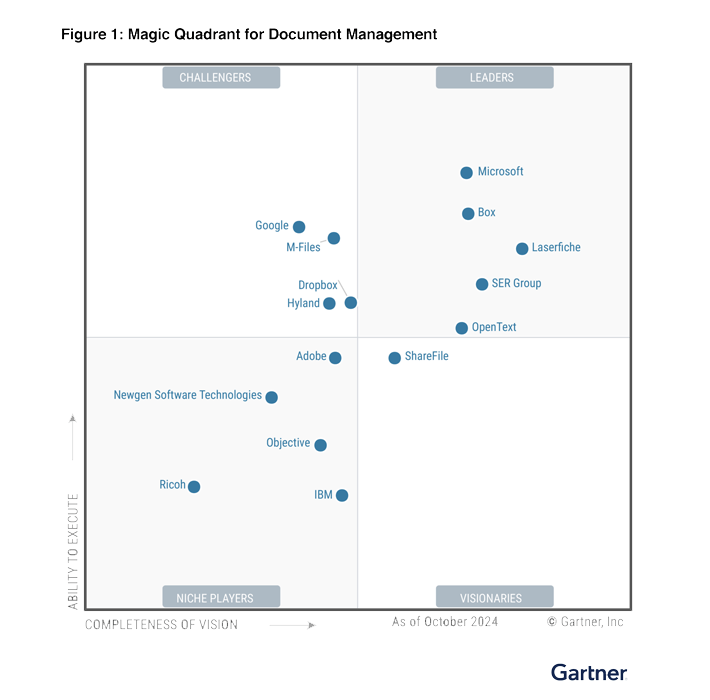In recent months, the conversation around generative AI (Gen AI) has moved beyond productivity and hype. While early use cases in the public sector focused on time-saving and process efficiency, the broader narrative is evolving toward the transformational potential of AI to unlock insights, improve public services, and anticipate citizen needs. As public sector leaders confront rising service expectations, tight budgets, and growing data complexity, the strategic deployment of Gen AI particularly through enterprise content management (ECM) and process automation presents a powerful path forward.
Laserfiche is at the forefront of this evolution. By embedding Gen AI capabilities such as Smart Fields into our platform, we enable agencies, municipalities, and educational institutions to move beyond automating tasks and begin unlocking institutional knowledge at scale. This article explores the forces shaping Gen AI adoption in the public sector and the unique value Laserfiche brings to this new chapter.
Technological Innovation: From Automation to Insight
Across the public sector, Gen AI is transitioning from a tactical tool to a strategic enabler. Initial use cases centered on automating repetitive work summarizing documents, generating email drafts, or assisting with data entry. But the technology’s next wave is defined by its ability to reveal patterns, surface actionable insights, and synthesize complex information across siloed systems.
Laserfiche’s Smart Fields exemplify this shift. By using AI to detect and understand content in real time, Smart Fields reduce manual data tagging and improve metadata accuracy. This goes far beyond convenience. It allows public sector organizations to create more intelligent content repositories, where relevant information is surfaced proactively and used to inform decisions from public health trends to policy implementation to citizen engagement strategies.
Moreover, the Laserfiche platform integrates Gen AI into core business processes, enabling more responsive workflows. For instance, natural language processing (NLP) capabilities can be used to classify incoming service requests, assign priority based on urgency, and trigger automated routing ensuring faster and more consistent delivery of services.
Changing Customer Behavior: From Task Automation to Data Stewardship
To fully realize the benefits of Gen AI, public sector organizations must rethink how they manage data and measure outcomes. The old model of digitizing for the sake of efficiency is giving way to a new imperative: leveraging digital assets for continuous learning and improvement.
This shift demands a cultural change. Agencies need to embrace their role as stewards of public data not just curators of records but strategic users of information to drive policy and operational excellence. In this context, Laserfiche acts as a connective tissue between structured processes and unstructured data, enabling agencies to treat every document, form, or communication as a potential source of insight.
Equally important is the need for responsible innovation. Citizens and students expect transparency in how AI is used, especially in areas like eligibility determination, grading, or benefits administration. Public sector leaders must pair Gen AI adoption with robust governance, including audit trails, consent tracking, and AI explainability features. Laserfiche’s commitment to compliance and transparency ensures that agencies can adopt AI with confidence.
Navigating Regulatory Change: Building Trust and Alignment
Governments around the world are moving quickly to regulate AI, with a growing emphasis on fairness, accountability, and data protection. In the United States, executive orders and state-level legislation are beginning to shape expectations for the use of AI in public services. The European Union’s AI Act, although not directly binding on U.S. institutions, is setting the tone globally by categorizing AI use cases by risk and imposing strict obligations for public sector applications.
Laserfiche is designed with these realities in mind. Our platform includes role-based access controls, automated retention policies, and end-to-end encryption to help organizations align with privacy and data management requirements. More critically, the platform’s explainable AI capabilities provide clarity into how decisions are made an essential safeguard in regulated environments.
As regulations mature, public sector leaders will need technology partners that offer more than just AI features. They will need systems that are auditable, secure, and aligned with emerging compliance frameworks.
Growth Opportunities: Serving Citizens and Students More Intelligently
The greatest untapped opportunity for Gen AI in the public sector lies in its potential to personalize and improve the citizen and student experience. Today’s constituents expect the same responsiveness from government that they receive from the private sector yet many agencies are hampered by legacy systems and data silos.
With Laserfiche, organizations can unify disparate data sources and automate multi-step interactions, allowing for intelligent service delivery. Imagine a student applying for financial aid who is guided through the process via an AI assistant that understands eligibility rules, validates documentation in real time, and tracks application status all integrated with a secure ECM backbone. Or a constituent filing a complaint about street repairs who receives proactive updates based on workflow progress, without ever needing to make a follow-up call.
These scenarios are not science fiction. They are being implemented today by forward-looking agencies using Laserfiche to reimagine how the government and education serves its stakeholders.
Conclusion: The Strategic Role of Gen AI in Public Service
As the Wired article suggests, the real value of Gen AI is not just in how fast it operates but in how deeply it can transform how organizations think and act. For the public sector, this means using AI not simply to accelerate processes, but to deliver on the promise of better governance, equity, and trust.
Laserfiche’s AI-powered platform, including capabilities like Smart Fields, helps agencies shift from reacting to anticipating, from managing data to unlocking insight, and from compliance to transformation. For leaders seeking to modernize operations, improve service delivery, and embrace the future of digital governance, the time to act is now.
The opportunity is no longer just to do more with less. It is to do better with more, more intelligence, more context, and more strategic value from every interaction.
See More on how Laserfiche is unlocking a new era in productivity and insight.
